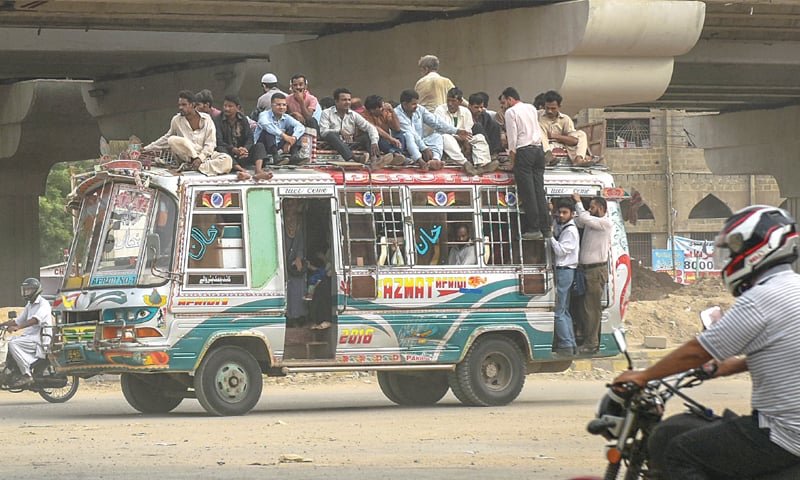
Public transport is essential for many people in Karachi, including daily-wage workers, factory employees, students, and office workers. It serves as a crucial lifeline for their various jobs and activities. It plays an essential role in a city’s social and economic structure, providing an affordable mobility solution amid Karachi’s rapidly growing population and sprawling urban landscape. Yet, despite its importance, the public transport system in Karachi remains heavily neglected, plagued by outdated infrastructure and an insufficient number of vehicles to serve the growing demand.
This already strained system now faces an even greater challenge with the accelerating impacts of climate change. Extreme weather patterns, including searing heat waves, unpredictable rains, and flash floods, amplify the daily hardships of commuters, from hazardous walking paths, severe heat while walking to bus stops, to extended travel times. Climate change exacerbates these difficulties, underscoring an urgent need to not only address infrastructure gaps but also adapt transport systems to withstand an increasingly volatile climate.
Increasing urbanization and climate change are further creating new challenges for these travellers, who have to face difficulties both as pedestrians and as users of public transport options in Karachi. Given the high number of people who walk to their destinations in Karachi, creating pedestrian-friendly infrastructure is essential. Properly designed pavements and walking paths not only provide safer routes but can also help address critical challenges like urban flooding, extreme heat, pollution and emissions. Elevated and well-drained sidewalks can prevent waterlogging, reducing the risk of accidents during the frequent flash floods that hit the city. Green cover along walking paths can offer much-needed shade, mitigating the effects of Karachi’s intense heat, especially during peak summer months. Tree-lined streets and shaded paths would make walking more comfortable and promote better air quality, benefitting the health of the many pedestrians who rely on these routes daily. Increasing accessibility is also crucial, and standards should be enforced regarding cleanliness, ramps for wheelchair users, and adequate lighting and ensure maintenance on them.
In practice, the importance of pavements to commuters is often overlooked. For decades, policymakers have prioritized private vehicles and roads at the cost of the public transport. As a result, pavements that are built not only remain small, but they are also shrinking in width or being encroached upon by residential and commercial actors (such as storefronts and parking spaces). In some cases they have vanished altogether to make way for ever wider roads, such as Kala Pull Road near JPMC Hospital off Shahrah-e-Faisal. Fifty nine percent of pedestrians, in a survey conducted by the Urban Resource Center as reported by Dawn, reported encroachments to be a hindrance in their journey.
This problem of pavement encroachment is getting worse due to increasing urbanization. From 1999 to 2021, the city’s green cover is estimated to have declined by 40 percent according to this article from Dawn which references a report from the Karachi Urban Lab. The cutting of trees to make way for developments means the paths pedestrians take are exposed to the sun more than ever before. The intersection of these two issues: rapid urbanization and climate change are at play side by side, and public transport users are one of the major casualties of this, leaving them vulnerable to health risks such as heat stress, heat stroke and chronic exhaustion.
The recent introduction of air-conditioned transport in Karachi from 2022 is a welcome, yet much delayed outcome. If Pakistan is to make things better for the country’s commuters, the policy makers need to realize that there is a crisis of imagination at large in the society when it comes to the users of public transport. That it is and always will remain undesirable, unhygienic and for the poor, them being the last priority.
Policymakers must acknowledge that improving public transport isn’t just about adding more buses; it involves a more systemic transformation of the entire commuting experience, which is tied to the way it is perceived, and intrinsically to the pedestrian journey. Attempts must be made to dignify and humanize users of public transport, who are most often poor. Media campaigns can be run to highlight the importance of walking and sustainable public transport.

